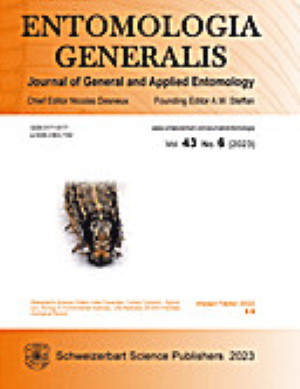In-vitro-expressed pxy-mir-34 shows high toxicity to multiple lepidopteran pests
IF 4.6
1区 农林科学
Q1 ENTOMOLOGY
引用次数: 0
Abstract
Lepidopteran pests cause enormous economic losses to agriculture globally. The control of these pests relies heavily on chemical insecticides, resulting in severe insecticide resistance and food safety concerns. Therefore, there is an urgent need to develop alternative green strategies. Our previous research revealed that the miRNA of the diamondback moth Plutella xylostella, pxy-miR-34-5p, may be a novel molecular target for multiple lepidopteran pests. However, the application strategy for pxy-miR-34-5p is not yet clear. In this study, pxy-mir-34 was successfully expressed in Escherichia coli to produce artificial miR-34 (amiR-34) on a large scale. Treatment with amiR-34 significantly repressed the expression of the ecdysone receptor (EcR) and 12 other key genes involved in the growth and development of P. xylostella. Feeding bioassays showed that amiR-34 was highly toxic to multiple lepidopteran pests, and pot experiments demonstrated that spraying with amiR-34 led to larval mortalities of 81.7%, 89.3%, and 90.8% for P. xylostella, Spodoptera frugiperda, and Spodoptera exigua, respectively, with a persistence of up to five d. These results indicate that amiR-34 has great potential for controlling multiple lepidopterous pests and they lay an important foundation for developing miRNA-based green pest control strategies.体外表达的 pxy-mir-34 对多种鳞翅目害虫具有高毒性
鳞翅目害虫给全球农业造成了巨大的经济损失。这些害虫的防治严重依赖化学杀虫剂,导致严重的杀虫剂抗药性和食品安全问题。因此,迫切需要开发替代性绿色战略。我们之前的研究发现,菱纹夜蛾的 miRNA pxy-miR-34-5p 可能是多种鳞翅目害虫的新型分子靶标。然而,pxy-miR-34-5p 的应用策略尚不明确。本研究成功地在大肠杆菌中表达了 pxy-mir-34,从而大规模生产出人工 miR-34(amiR-34)。用 amiR-34 处理可显著抑制蜕皮激素受体(EcR)和其他 12 个参与木虱生长发育的关键基因的表达。喂食生物测定表明,amiR-34 对多种鳞翅目害虫有剧毒,盆栽实验表明,喷洒 amiR-34 可导致 P. xylostella、Spodopter 和 Spodopter 幼虫死亡率分别为 81.7%、89.3% 和 90.8%。这些结果表明,amiR-34 具有防治多种鳞翅目害虫的巨大潜力,为开发基于 miRNA 的害虫绿色防控策略奠定了重要基础。
本文章由计算机程序翻译,如有差异,请以英文原文为准。
求助全文
约1分钟内获得全文
求助全文
来源期刊

Entomologia Generalis
生物-昆虫学
CiteScore
7.10
自引率
18.80%
发文量
72
审稿时长
>12 weeks
期刊介绍:
Its scope covers all aspects of basic and applied research dealing with insects and more broadly with arthropods inhabiting wild, agricultural and/or urban habitats. The journal also considers research integrating various disciplines and issues within the broad field of entomology and ecology.
Entomologia Generalis publishes high quality research articles on advances in knowledge on the ecology and biology of arthropods, as well as on their importance for key ecosystems services, e.g. as biological control and pollination. The journal devotes special attention to contributions providing significant advances (i) on the fundamental knowledge and on sustainable control strategies of arthropod pests (including of stored products) and vectors of diseases, (ii) on the biology and ecology of beneficial arthropods, (iii) on the spread and impact of invasive pests, and (iv) on potential side effects of pest management methods.
Entomologia Generalis welcomes review articles on significant developments in the field of entomology. These are usually invited by the editorial board, but proposals may be sent to the Editor-in-Chief for preliminary assessment by the editorial board before formal submission to the journal. The journal also considers comments on papers published in Entomologia Generalis, as well as short notes on topics that are of broader interest.
 求助内容:
求助内容: 应助结果提醒方式:
应助结果提醒方式:


